Discussion
Mineralogy and Preservation
Solution mode
The major and minor elemental data of the samples was evaluated to determine bulk elemental composition, as well as the preservation state of the rock samples. While most sampled powders registered Mg/Ca ratios indicative of dolomite, the Assem Limestone presented low Mg/Ca ratio values and, therefore, the sample bulk mineralogy is mostly calcite.
The weak and strong acid digestions showed similar Mg/Ca ratios. Si, Al and K concentrations were lower in samples processed using the weak acid. Thus, weak digestion samples are expected to provide better proxies for oceanic redox conditions since less aluminosilicates were dissolved during sample digestion. Samples corresponding to the Tindelpina Shale (Tindelpina 4.5m), showed some of the highest values for Al and K, indicating presence of aluminosilicates in the samples. The samples Rasthof S2-a an S5-c, Assem T3-15-12-a, and Beck Spring 1.2d, showed the lowest levels of aluminosilicate content in weak acid digestions, indicating low contamination levels in sampled materials.
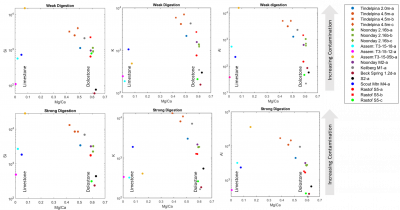
Manganese and iron contents served as proxies for diagenetic processes, indicating post-depositional alteration of the sampled rock. Thus, higher concentrations of such elements suggest poor preservation of samples. Similar to the aluminosilicate contamination results, Tindelpina Shale samples, along with Assem T3-15-05b-a powdered sample, showed the highest concentrations of manganese and iron, indicating diagenetic alteration of the original matrix. Samples Rasthof S2-a an S5-c, Assem T3-15-12-a, and Beck Spring 1.2d showed the lowest Mn and Fe contents, suggesting good sample preservation.
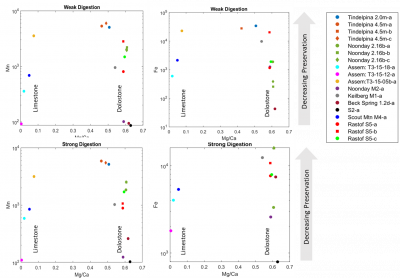
Laser Ablation Spots
To evaluate the mineralogy and preservation state of the laser ablated spots, we evaluated average Mg/Ca values against Si, Al and Fe concentrations. Most sampled spots, except Keilberg Mbr spots, presented a Mg/Ca ratio greater than 0.03, indicating that dolostone is the predominant phase. Mirassol d’Oeste SA-26 spot, as well as the Assem Limestone T3-15-12 spot, registered the greatest Al concentrations. Moreover, these spots, along with the Scout Mountain Member, also showed relatively high Si and Fe contents, indicating that these sampled areas may not be as well preserved as other sampled locations.
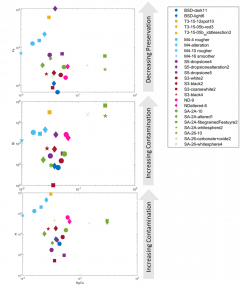
Oceanic Redox
Select plots from our results are presented here to aid in the discussion of our interpretations. Our focus is on the following: 1) characterizing the oceanic redox state at each locality during cap carbonate deposition, and 2) attempting to correlate cap carbonate localities within a specific Neoproterozoic glacial episode on the basis of REE patterns and enrichments.
Our solution mode interpretations of bulk carbonate chemistry are based on the results from the weak acid digests. This is because these were less contaminated by aluminosilicate phases during the leeching process, and likewise are more reflective of oceanic conditions at the time of cap carbonate precipitation. These are also compared with results from in-situ laser ablation spot targets. In general, the solution mode data was more precise. Laser ablation analyses have a much lower signal/noise ratio than did solution mode mode by several orders of magnitude. This lack of precision is what is inferred to cause the sawtooth pattern, particularly for the MREEs and HREEs, in several spot analyses.
Pre-Cryogenian
Assem Limestone= orange; Beck Spring Dolomite=blue
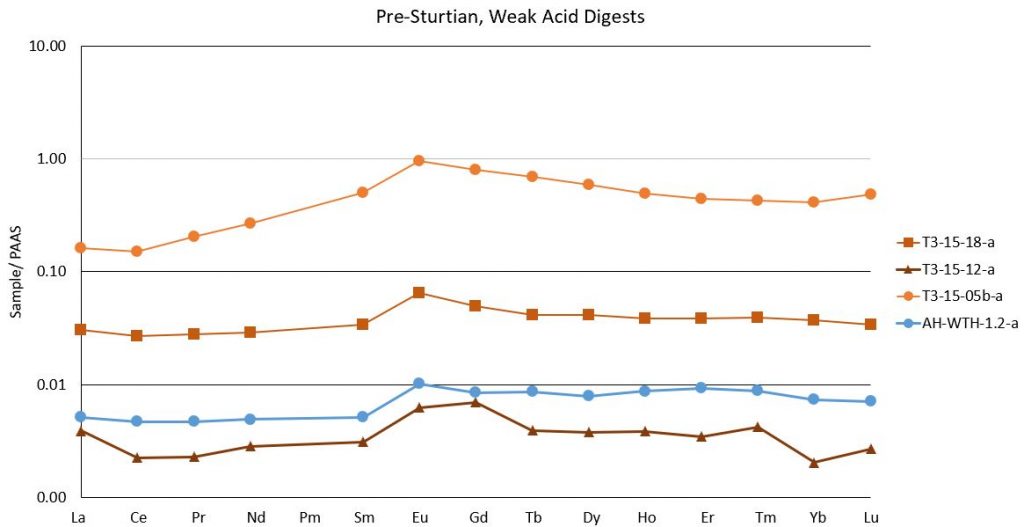
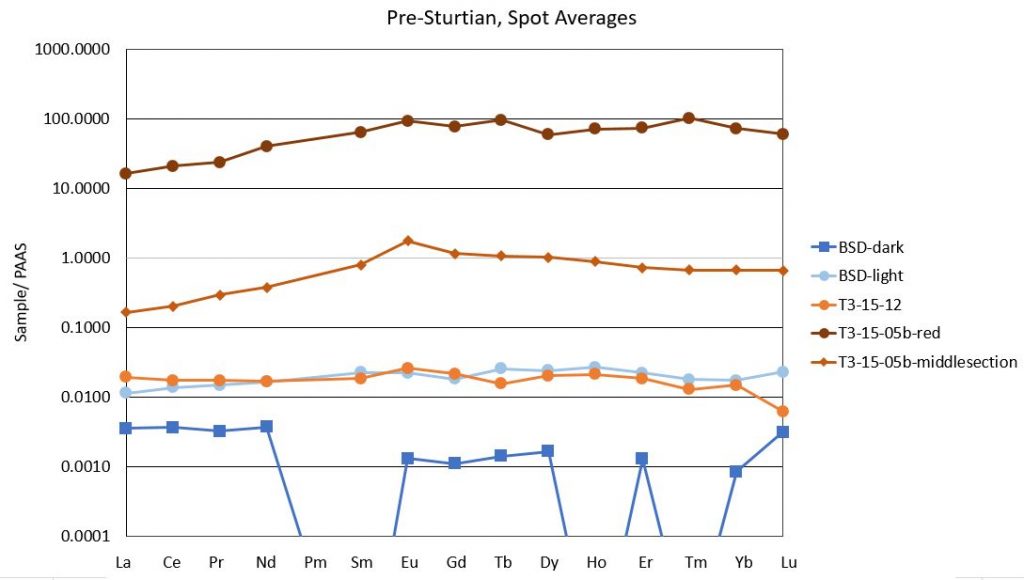
The Beck Spring Dolomite and Assem Limestone have similar REE patterns characterized by the lack of a Ce anomaly and the presence of a minor positive Eu anomaly. This is consistent with oceanic anoxia at both locations during the carbonate precipitation. The variability in REE concentrations suggest different local environments of deposition for the Assem Limestone and Beck Spring Dolomite.
Spot analyses of the Beck Spring Dolomite dark laminations return poor quality results for many REEs and should not be considered further; however, the light laminations of the Beck Spring Dolomite match the REE pattern and concentrations of the bulk rock solution mode analysis. Loyd and Corsetti (2010) argue against a primary depositional origin for the alternating laminations, so caution should be exercised in considering the Beck Spring compositional data to be truly reflective of the oceanic environment at the time of deposition. Nonetheless, Shuster et al. (2018) obtained a similar REE pattern to ours for the Beck Spring Dolomite (see their Fig. 15), along with a similar interpretation to ours.
The spot data for the Assem Limestone also indicate some interesting trends. First, the spot data for T2-15-05b were of a “rusty” looking part of the sample that was clearly altered. Here, we see that the the alteration tends to result in higher overall REE concentrations. Following this, the solution mode data for T3-15-05b has higher REE concentrations than the spot data taken from the middle, less-altered part of the same sample. This indicates that the micro-drilling likely incorporated some of the “rusty” altered part of the limestone. The conclusion is also apparent when comparing the solution mode and spot data for Assem Limestone sample T3-15-12.
Post-Sturtian
Rasthof Formation= Black, Tindelpina Shale= Blue, Yellow= Scout Mountain Member
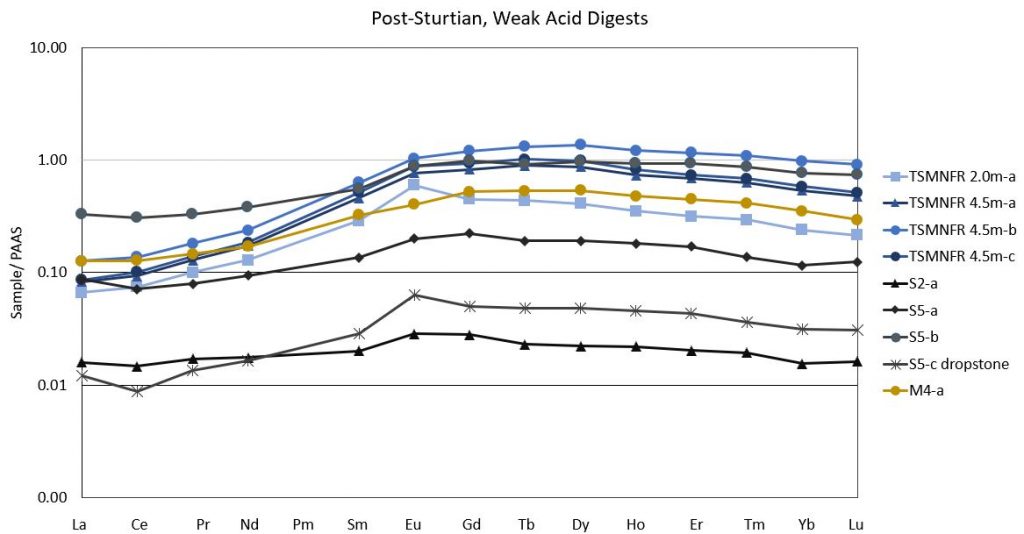
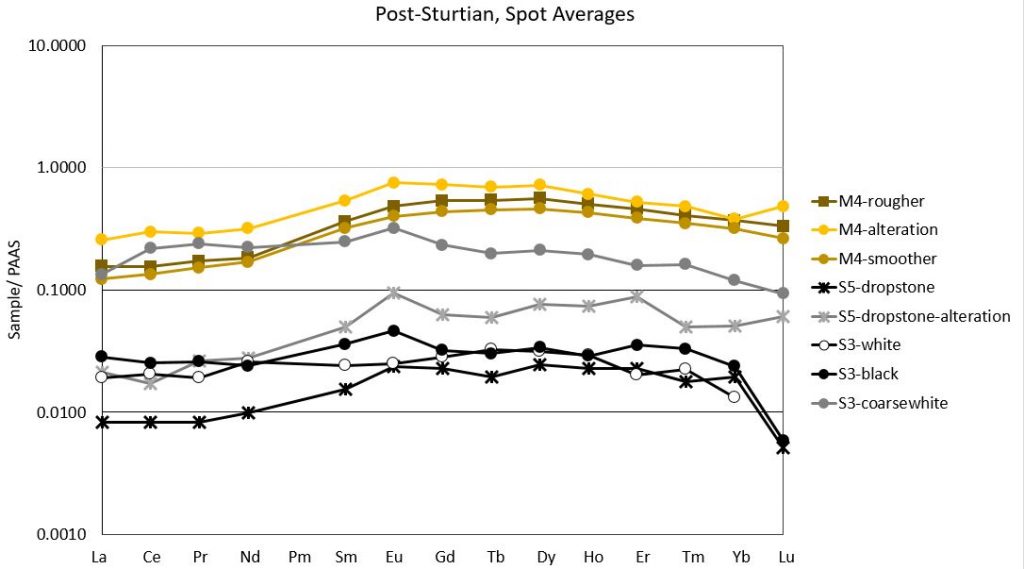
The Tindelpina Shale and Scout Mountain Member samples are characterized by the lack of a Ce anomaly and a slight positive Eu anomaly. In contrast the Rasthof Formation samples have slight negative Ce anomalies and minor positive Eu anomalies. These contrasts suggest that the Tindelpina/Scout Mountain and Rasthof cap carbonates formed under different environmental conditions. The Rasthof environment could not have been anoxic due to the occurrence of negative Ce anomalies; however, it is possible that the Tindelpina and Scout Mountain environments were anoxic since no Ce anomaly is present.
Anoxia is more likely in TSMNFR 2.0m-a than the younger Tindelpina Shale samples from 4.5m stratigraphic height, as the Eu anomaly is more pronounced. Therefore, the Tindelpina Shale may have been deposited during a period of increasing oxidation of the depositional environment.
The syn-Sturtian Scout Mountain Member differs from the Tindelpina samples in that it is relatively slightly LREE enriched and MREE/HREE depleted. This may just be due to better preservation (lower BSI of 1.6 vs 1.9-2.0 for Tindelpina samples; see results workbook). Regardless, the similarities in REE patterns and concentrations imply remarkably similar depositional environments for both cap carbonates. This is consistent with these two cap carbonates forming following the a single global snowball-Earth type glaciation; however, snowball Earth is not the only possibility. Both cap carbonates may also have formed follow temporally or spatially distinct glaciations in post-glacial environments that were similar due occurrence along similar latitudes, or placement in similar tectonic settings.
The dropstone analyzed in the Rasthof formation has the most pronounced Ce and Eu anomalies of the Post-Sturtian samples. The significant negative Ce anomaly precludes deposition under anoxic conditions for the formation from which this dropstone is derived. A moderate BSI index value of 1.642 from the weak acid digest suggest this sample is about as well preserved as the rest of the Rasthof carbonates (see results workbook).
The spot and solution mode data for the Post-Sturtian samples tend to match much better than they did for the Pre-Sturtian samples. Once again, spot analyses of obviously altered areas were enriched in REEs relative to less-altered areas (see S5-dropstone and M4-a; altered and unaltered). Overall, the similarities in REE patterns and concentrations between both altered and unaltered areas indicated that the solution mode data did in fact sample areas deemed to be less-altered, or at least as well-preserved as the “fresher” areas targeted for laser ablation spot analysis.
Post-Marinoan
Noonday Dolomite=Red/Pink, Keilberg Formation= Green
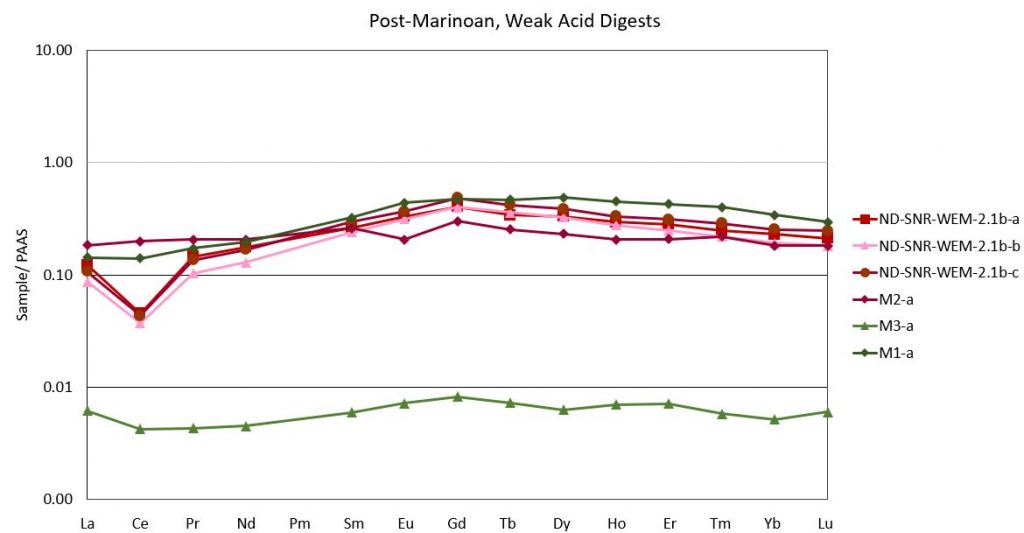
The Noonday Dolomite samples rom War Eagle Mine (labeled WEM, all drilled from different areas of the same slab) are characterized by a pronounced negative Ce anomaly and no Eu anomaly. This is strong evidence for an oxygenated ocean at the time of deposition. The other Noonday sample, M2-a, lacks a Ce anomaly and has a slightly negative Eu anomaly. The negative Eu anomaly is inconsistent with an anoxic ocean where Eu2+ should be enriched in carbonate samples, and may imply deposition in very near shore environments since no negative Ce anomaly is present (Tostevin et al. 2016, see their Discussion section).
The Keilberg Formation samples are characterized by trends similar to M2-a of the Noonday dolomite, but by very different concentrations. M1-a is very similar to the Noonday samples with the exception that it only has a very slight Ce anomaly. M3-a is much less enriched than any of the other Post-Marinoan samples from either locality, and only has a very slight negative Ce anomaly as well. The concentration difference between M1-a and M3-a could potentially be indicative of a rapid change in depositional characteristics. Alternatively, and perhaps more likely, is a difference in preservation and/or incorporation of aluminosilicate or hydroxide material during the digestion process.
M1-a matches well with most Noonday samples, and therefore suggests depositional environments of similar characteristics. A plausible correlation exists between M1-a and the Noonday Dolomite, which is consistent with widespread deglaciation following a snowball Earth event. As with our Post-Sturtian correlation of the Tindelpina Shale with the Scout Mountain Member, other explanations can explain this correlation as well.
Shown below is a composite version of the solution mode Post-Marinoan REE diagram above with the average laser ablation spot data from 2 Mirassol D’Oeste samples (SA-2A- and SA-26).
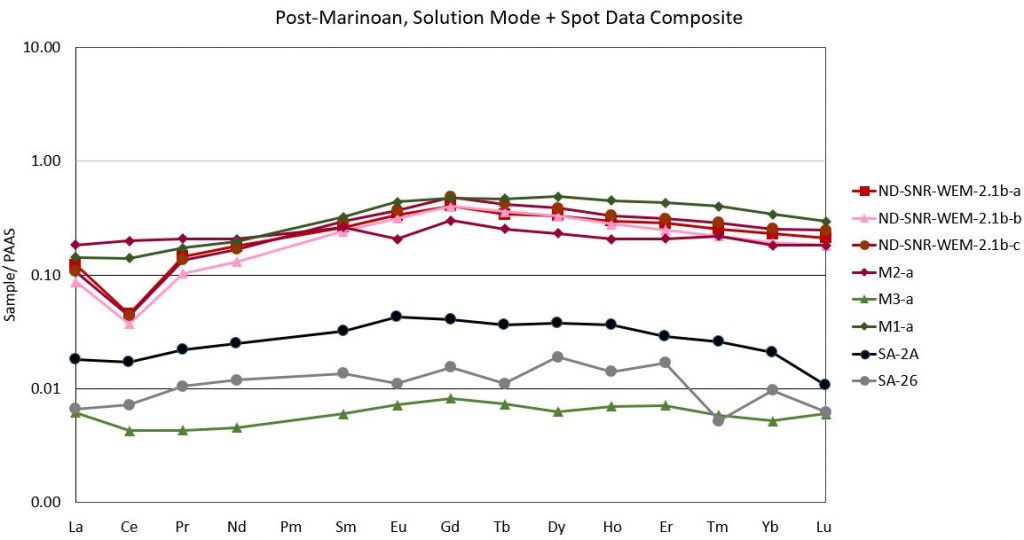
Both Mirassol D’Oeste samples have minor negative Ce-anomalies. SA-2A has a slight positive Eu anomaly, whereas SA-26 has a slight negative Eu anomaly. Collectively, these samples likely do not represent strongly anoxic conditions. In terms of REE concentrations, they are most similar to the Keilberg sample M3-a; however, they do not match well in terms of overall patterns. On the basis of this data above, the Mirassol D’Oeste Formation does not correlate well with either the Noonday Dolomite or Keilberg Formation. For a proper assessment, bulk rock data should be collected on the Mirassol D’Oeste Formation in the future.
Noonday Dolomite=Pink,Red, Mirassol D’Oeste= blue, green, yellow
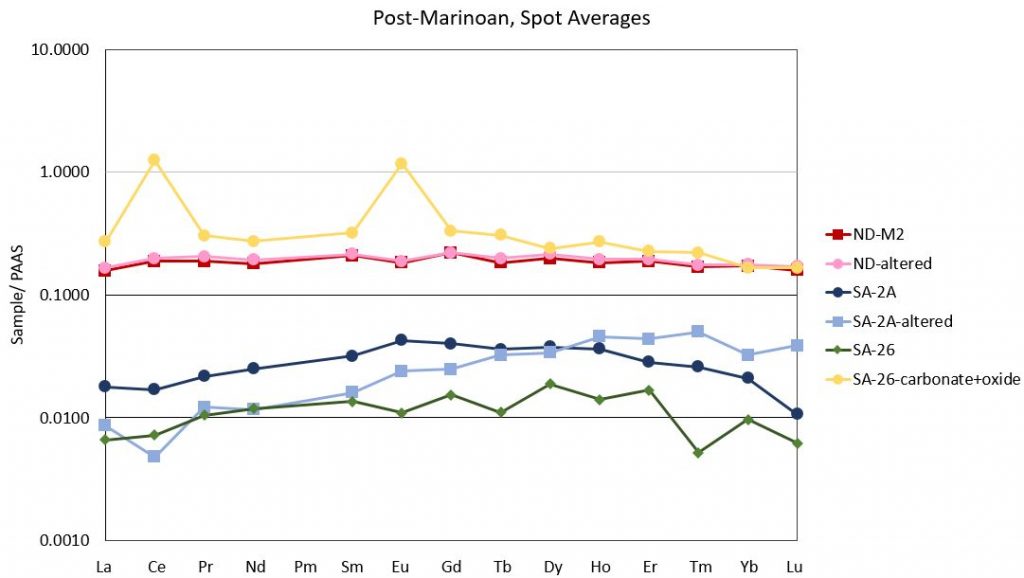
The spot data for the Noonday Dolomite indicate almost the exact same trends as the solution mode data for sample M2-a. The REE pattern has a very low slope with a slightly positive Ce anomaly and a slightly negative Eu anomaly. Also of interest in the REE pattern produced by Mirassol D’Oeste sample SA-26. The REE pattern for SA-26 has LREE>HREE with prominent positive Ce and Eu anomalies. Visually, the features analyzed in the carbonate+oxide spot class appeared to be some sort of oxide. These presumed oxides may possibly be Fe or Mn hydroxides that precipitated in the upper water column of oxygenated oceans (and later settled) that cause negative Ce-anomalies to occur in carbonates as they precipitate. If that is the case, it would be further evidence that the Mirassol D’Oeste carbonates precipitated from oxic seawater.
Summary REE Plot
Shown below is an REE plot with the average of all solution mode weak acid digest data (as well as laser ablation spot data for Mirassol D’Oeste) for an age group plotted. This plot shows the gradual transition from anoxic to oxic conditions from Pre-Sturtian to Post-Marinoan glaciations as positive Eu anomalies become diminished and negative Ce-anomalies increase.
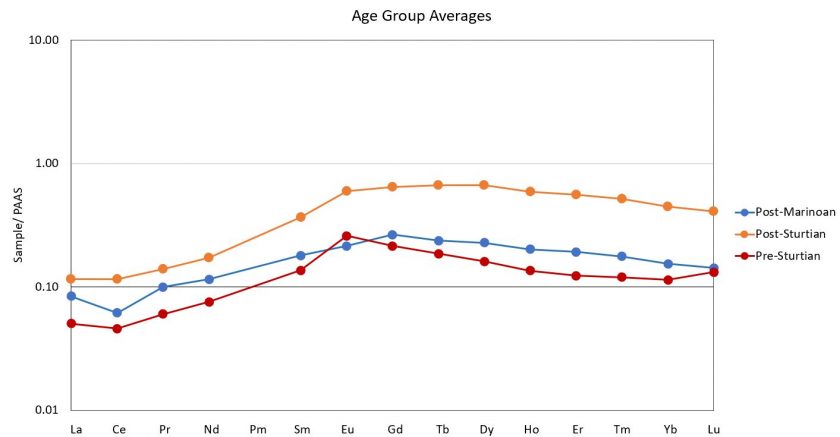
*Post-Sturtian average excludes the Rasthof dropstone sample S5-c because it predates the Rasthof formation.
References
Loyd, S.J., and Corsetti, F.A., 2010, The Origin of the Millimeter-Scale Lamination in the Neoproterozoic Lower Beck Spring Dolomite: Implications for Widespread, Fine-Scale, layer-Parallel Diagenesis in Precambrian Carbonates: Journal of Sedimnetary Research, v.80, p. 678-687, doi:https://doi.org/10.2110/jsr.2010.063.
Shuster, A.M., Wallace, M.W., van Smeerdijk-Hood, A., and Jiang, G., 2018, The Tonian Beck Spring Dolomite: Marine dolomitization in a shallow, anoxic sea: Sedimentary geology, v. 368, 83-104, doi:https://doi.org/10.1016/j.sedgeo.2018.03.003.
